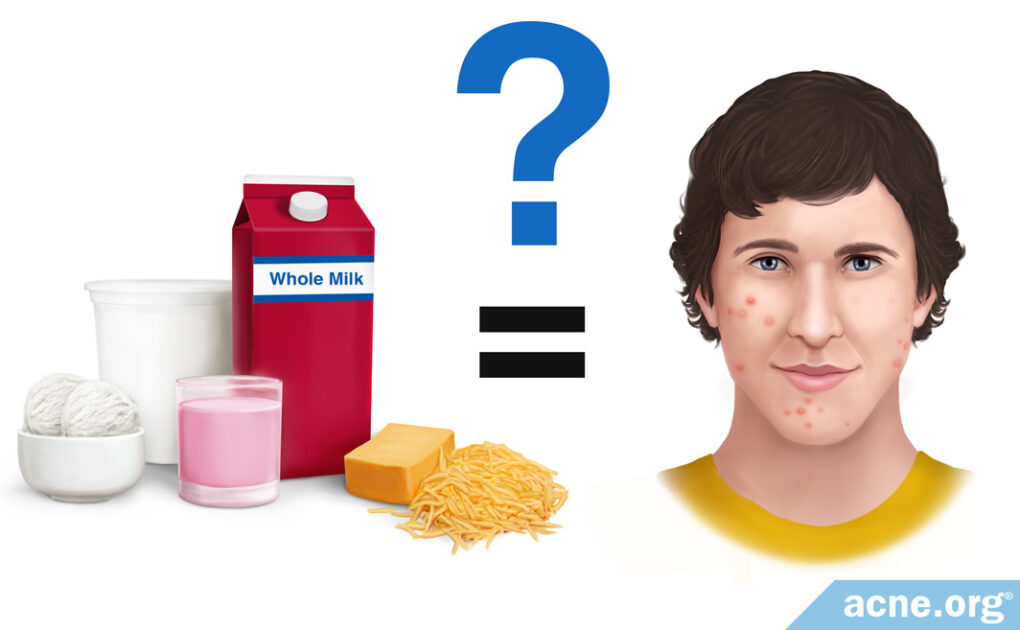So Far One Study Shows People who Are Lactose Intolerant May Suffer Less with Acne

The Essential Info
People with lactose intolerance are unable to fully digest the sugar (lactose) in dairy products, the consumption of which leads to:
- Gas
- Bloating
- Diarrhea
But what about acne? Does ingesting dairy lead to acne when you are lactose intolerant, or lactose tolerant for that matter? Only one recent study has explored the link between lactose intolerance and acne. According to this study, people who are lactose intolerant are less likely to suffer from acne compared to those that are lactose tolerant, and if lactose intolerant people do develop acne, their acne tends to be less severe. However, more research is needed to confirm this connection.
My Take on This: The reason I wanted to look into lactose tolerance and acne is because there is so much confusion over whether dairy and acne are related. I wondered if perhaps dairy only led to more acne symptoms in people who could not digest it correctly. However, as it turns out, based on the one study that has been published on this topic to date, the opposite might be true: people who can digest dairy might experience more acne. If this really is true–which it is still far too soon to say for sure–why would this be? It could be because when lactose tolerant people ingest dairy, their body effectively turns the lactose into sugar, and there is some evidence that high-sugar diets may lead to more acne symptoms.

The Science
- The Body Needs Lactase to Properly Digest Dairy
- Who Maintains Lactase Persistence, and Who Does Not?
- Does Everyone with Lactase Non-persistence Experience Lactose Intolerance?
- A Closer Look at Lactose Intolerance in the Body
- Lactose Intolerance Symptoms
- Lactose Intolerance and Acne
- Why Might Lactose Tolerant People Experience More Acne?
- Lactose Tolerant or Intolerant: What Does This Entail for Me?
The Body Needs Lactase to Properly Digest Dairy
Almost all infants are able to digest milk and specifically lactose, the sugar in milk and other dairy products. To digest dairy, the body needs a specific enzyme in the small intestines called lactase. Lactase breaks down lactose into glucose and galactose, which then pass through the wall of the bowel into the bloodstream, where the body uses them for energy.
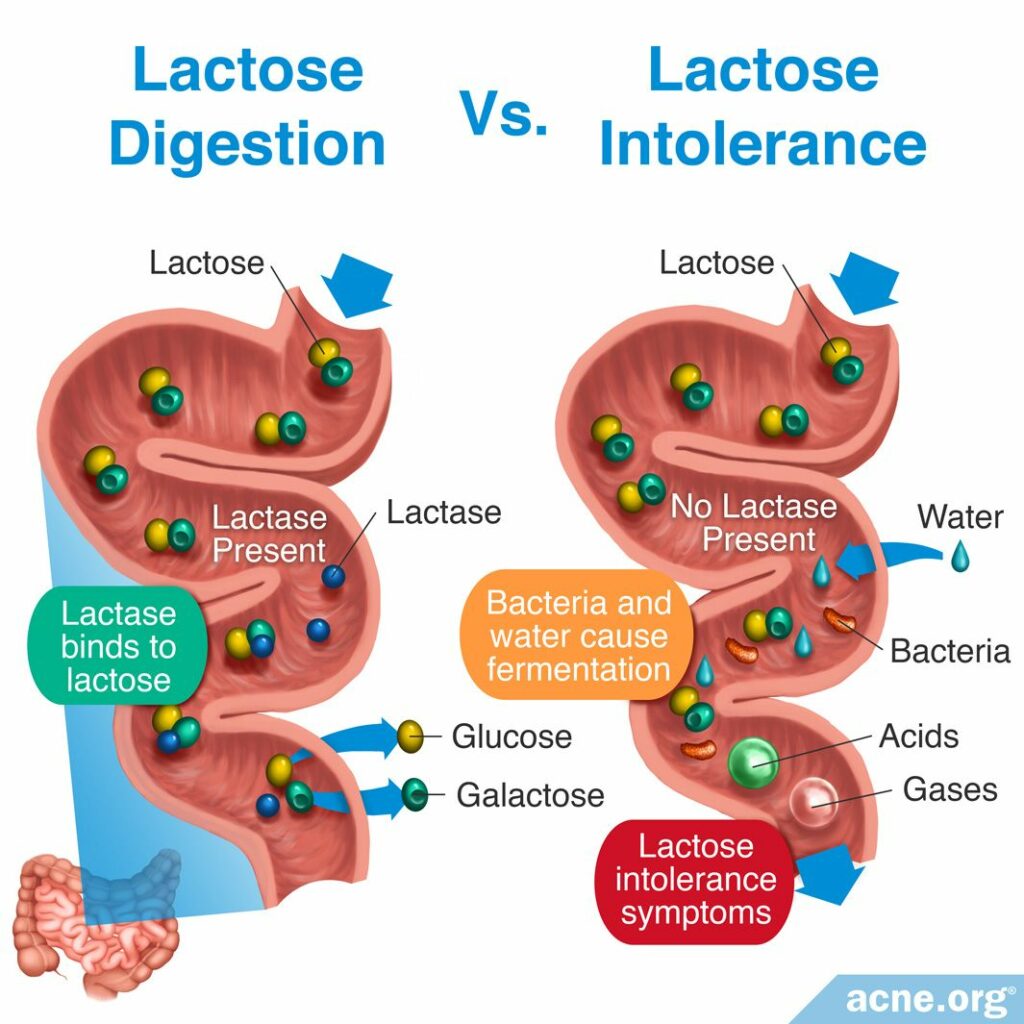
After infancy, most people gradually produce less lactase, leading to the reduced ability to digest lactose. Therefore, most people in the world (about 65%1) eventually develop lactase non-persistence, meaning the body does not persist in producing enough lactase to digest dairy.
People who are able to digest dairy into adulthood can do so because their bodies continue to produce lactase, and they are said to have lactase persistence.
Who Maintains Lactase Persistence, and Who Does Not?
Lactase persistence is more common in populations that have been consuming dairy for many centuries. For example, northern Europeans are thought to have introduced dairy into the diet about ten thousand years ago, leading to a genetic mutation (a permanent, inheritable alteration in a gene) that underlies lactase persistence. Today, people in northern European countries consume dairy products throughout their lives, just like their ancestors did. In contrast, in many parts of Asia, a place where historically people did not use animal milk for food, the overwhelming majority of people have lactose non-persistence.
This table shows the percentage of people with lactase non-persistence by ethnic group:3
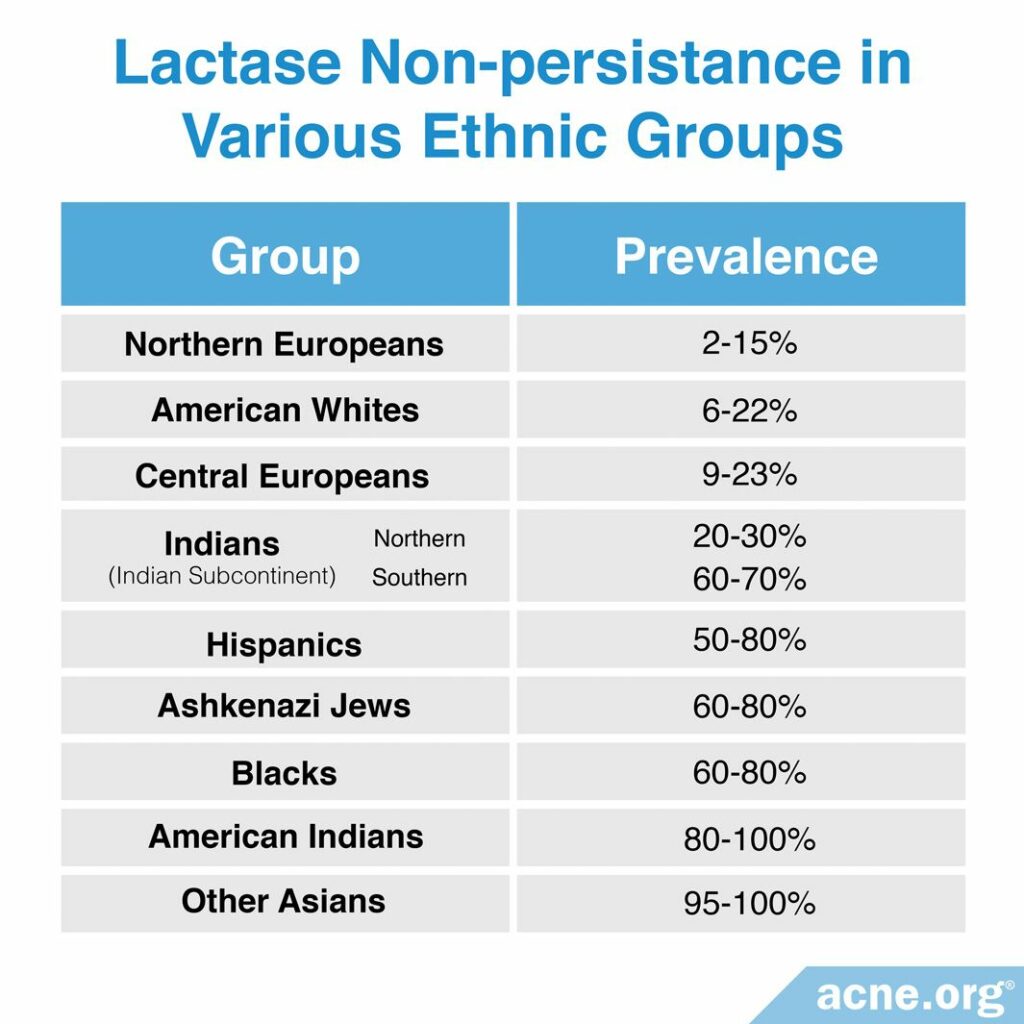
Does Everyone with Lactase Non-persistence Experience Lactose Intolerance?
Lactose intolerance is essentially the same as lactase non-persistence. The only difference is that some lactase non-persistent people do not experience symptoms, but all lactose-intolerant people do. In other words, lactase non-persistence does not always lead to lactose intolerance.
Most of the world’s population is lactase-non-persistent, but not all experience the symptoms of lactose intolerance since other factors also affect tolerance, such as:4
- The quantity of dairy consumed and how much is consumed at one time. In other words, if a lactose non-persistent person only eats a small amount of dairy, they may not experience symptoms.
- The amount of lactose in the dairy product. As an example, sour cream contains far less lactose compared to milk, so sour cream leads to far less symptoms.
According to the National Institute of Health, “Most people with lactase non-persistence retain some lactase activity and can include varying amounts of lactose in their diets without experiencing symptoms. Often, affected individuals have difficulty digesting fresh milk but can eat certain dairy products such as cheese or yogurt without discomfort.”2
[There is a list of various dairy products and how much lactose they contain further down in this article.]
A Closer Look at Lactose Intolerance in the Body
When the lactase enzyme is absent, lactose cannot be broken down and therefore remains in the bowel. From the small intestine, lactose is then transported into the large intestine, where bacteria change it into a form of sugar that cannot pass through the intestinal wall called monosaccharides. These monosaccharides stay in the bowel and attract more water, turning normal stool into diarrhea. Also, the process of changing lactose into monosaccharides produces gasses that cause bloating, abdominal pain, gas, and diarrhea.3
The following diagram shows what happens when the body no longer produces adequate lactase and the person experiences lactose intolerance.
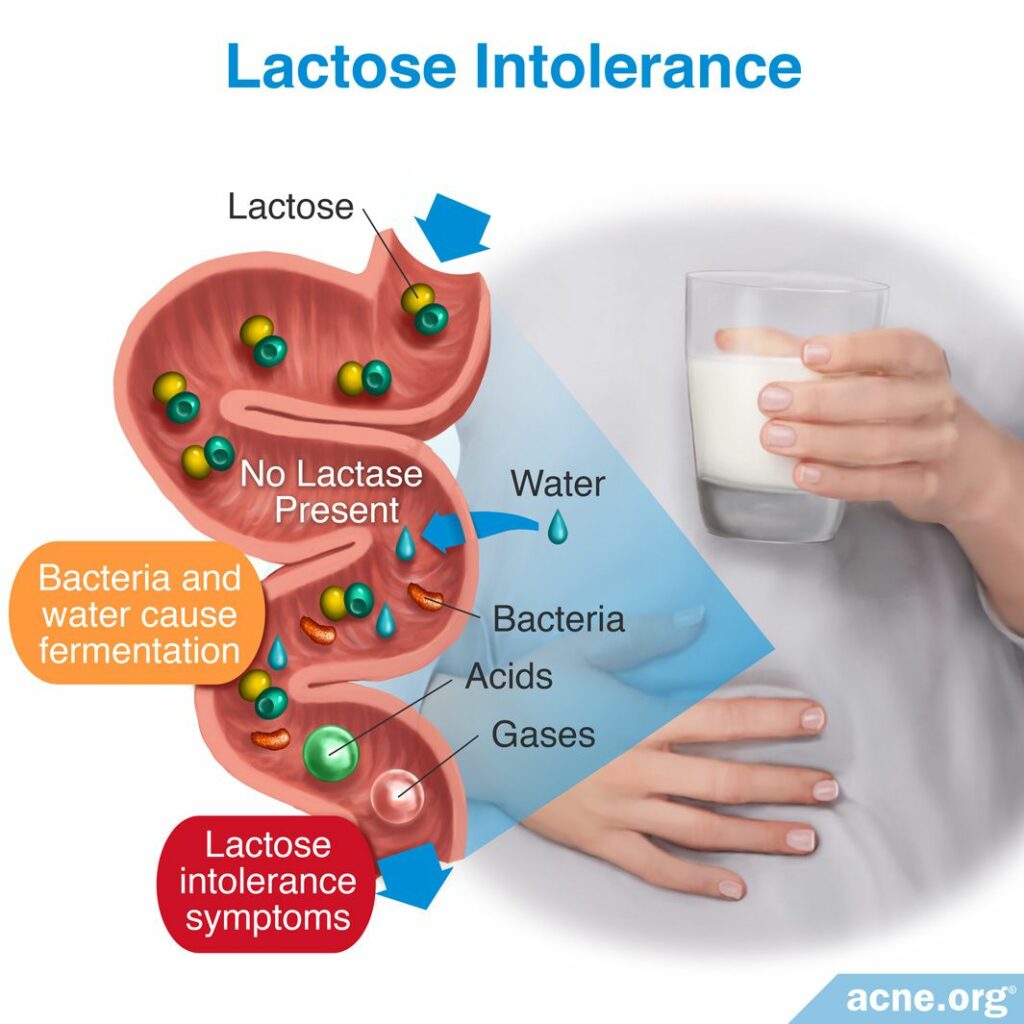
Lactose Intolerance Symptoms
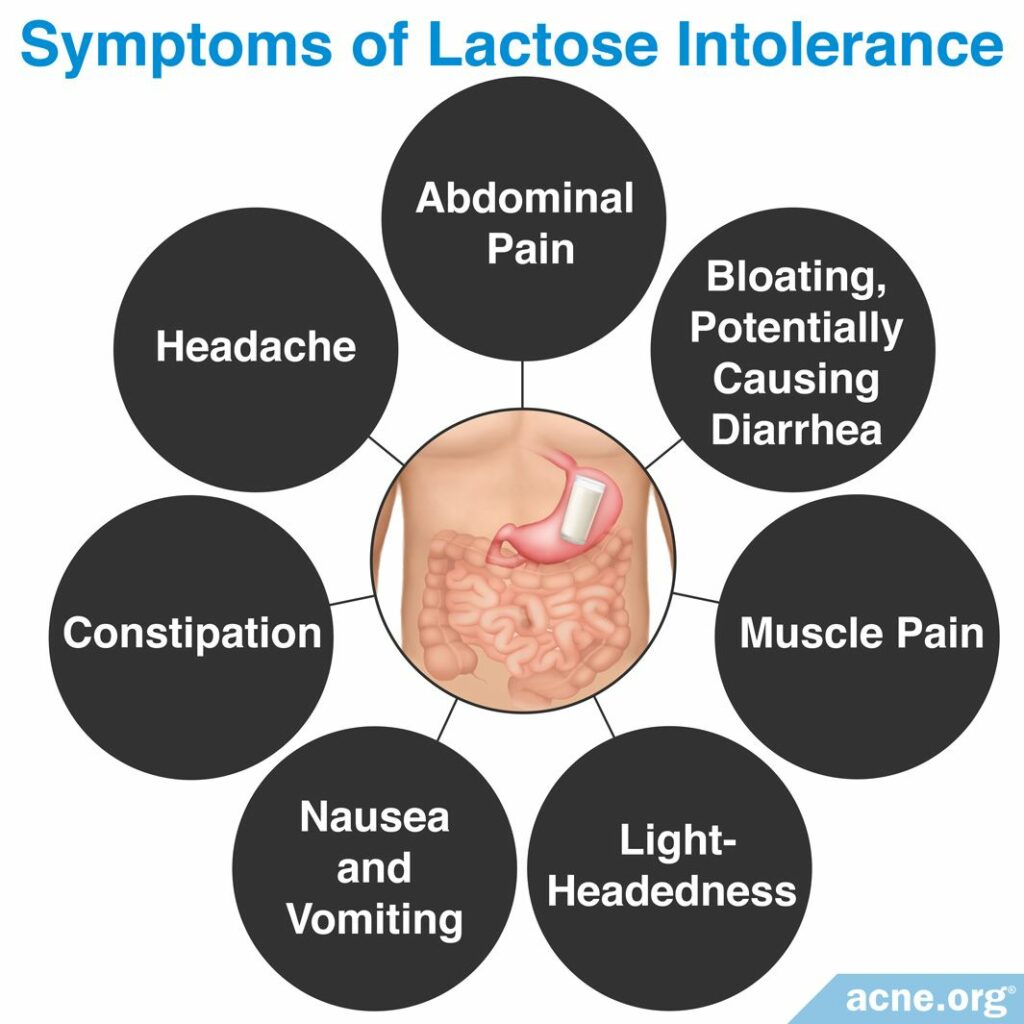
The symptoms of lactose intolerance typically occur between 30 minutes and 2 hours after eating or drinking dairy. The most common symptoms are:
- Abdominal pain
- Bloating of the belly caused by the presence of gas in the intestines, which can lead to diarrhea
People may also experience:
- Constipation
- Nausea and vomiting
- Headache
- Lightheadedness
- Muscle pain3
Lactose Intolerance Symptoms
If you experience the symptoms above after consuming dairy, ask your doctor to test you for lactose intolerance. There are 4 tests doctors can use to diagnose lactose intolerance, in order from most to least common:
- [Most common] Hydrogen breath test (HBT): In this test, a doctor repeatedly measures the amount of a gas called hydrogen in your breath before and after you consume lactose. The idea is that if your body can’t properly digest dairy, bacteria in your gut will take over the task of trying to break down the dairy, producing hydrogen gas in the process. If the amount of hydrogen in your breath increases by more than 20 ppm (parts per million) after you consume lactose, this indicates that you may suffer from lactose intolerance. This test is simple, inexpensive, and reliable, making it most popular with doctors.
- Genetic test: In this test, a doctor sends a sample of your DNA, usually taken by swabbing your cheek or drawing a small amount of blood from a vein, to a lab. The lab then checks whether you may have a mutation, meaning an abnormal change, in the gene for lactase (note: this is not the same thing as lactose). Lactase is the enzyme your body needs to digest the lactose found in dairy. If the lactase gene is mutated, that suggests your body may not be producing the correct lactase enzyme, causing your body to be unable to properly digest lactose.
- Quick lactase test: In this test, which is performed under sedation, a doctor takes a small sample of the inner lining of your intestine using an endoscope (a tube with a small camera that is inserted through your mouth). The doctor then sends the sample to a lab, where lab technicians place it in a petri dish together with lactose. If the tissue from your intestine is able to digest the lactose, a dark blue color will appear. If the petri dish turns light blue, that means your intestines are somewhat able to digest the lactose in dairy, but not very well. If there is no color change, this means your body is completely unable to digest lactose. Despite its name, this test is not particularly quick, as you need to undergo a somewhat invasive procedure at a clinic or hospital and then wait for the results to come back from the lab. Therefore, doctors only perform this test if they have an additional reason why they need to look at your intestines with an endoscope.
- [Least common] Lactose tolerance test (LTT): In this test, a doctor gives you lactose to consume. The doctor draws your blood before you ingest the lactose, and then 30 minutes, 60 minutes, and 120 minutes after you have ingested the lactose in order to measure the level of blood sugar. If your body is able to properly digest the lactose, your blood sugar level should rise. On the other hand, if there are no blood sugar spikes after you consume the lactose, this suggests that you may be lactose intolerant. However, this test is rarely used because it has a high rate of errors.5,6
Lactose Intolerance and Acne
To date, only one study has looked for a relationship between lactose intolerance and acne. This study concluded that people who are lactose intolerant are less likely to suffer from acne or, if they do, they tend to have less severe acne compared to people who are lactose tolerant.
The study was performed in the United States and published in the Journal of the European Academy of Dermatology and Venereology in 2019. The researchers combed through the medical records of over 6 million patients to find any patients who had been diagnosed either with lactose intolerance or with acne over a 17-year period. The scientists included any patients between the ages of 18 and 89 years who received one or both of these two diagnoses between January 2001 and November 2017.
The researchers found that out of a total of 2,970 lactose intolerant patients, only 7.7% had a diagnosis of acne. On the other hand, out of the 272,125 patients who were lactose tolerant, 15.2% suffered from acne. In other words, lactose tolerant people were twice as likely to have acne as lactose intolerant people.
In addition, the lactose intolerant patients who did have acne were much less likely to have severe forms of acne compared to the lactose tolerant patients.
The researchers speculated that consuming dairy products may raise the levels of a hormone called IGF-1, which is indirectly linked to acne. Since lactose intolerant people are unable to digest dairy products, they may not experience this rise in IGF-1 and may therefore be less likely to develop acne. However, the scientists also highlighted the limitations of their study, such as that they could only access brief medical records for each patient, made at the time of initial diagnosis. Therefore, they were unable to prove that dairy consumption contributes to acne or that lactose intolerance makes acne less likely. The study authors noted the need for further research in this area.7
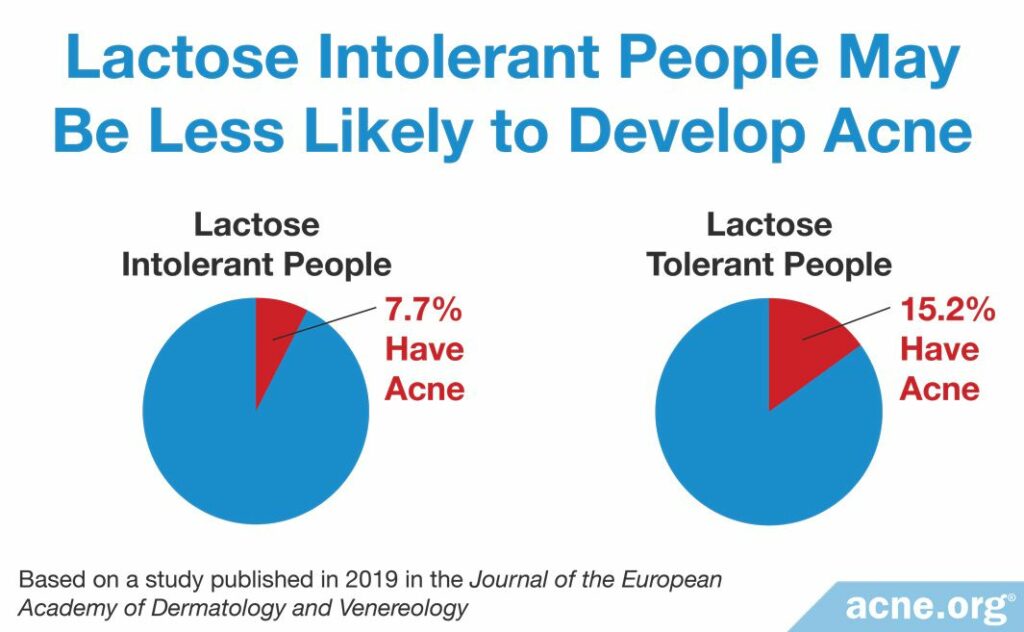
Why Might Lactose Tolerant People Experience More Acne?
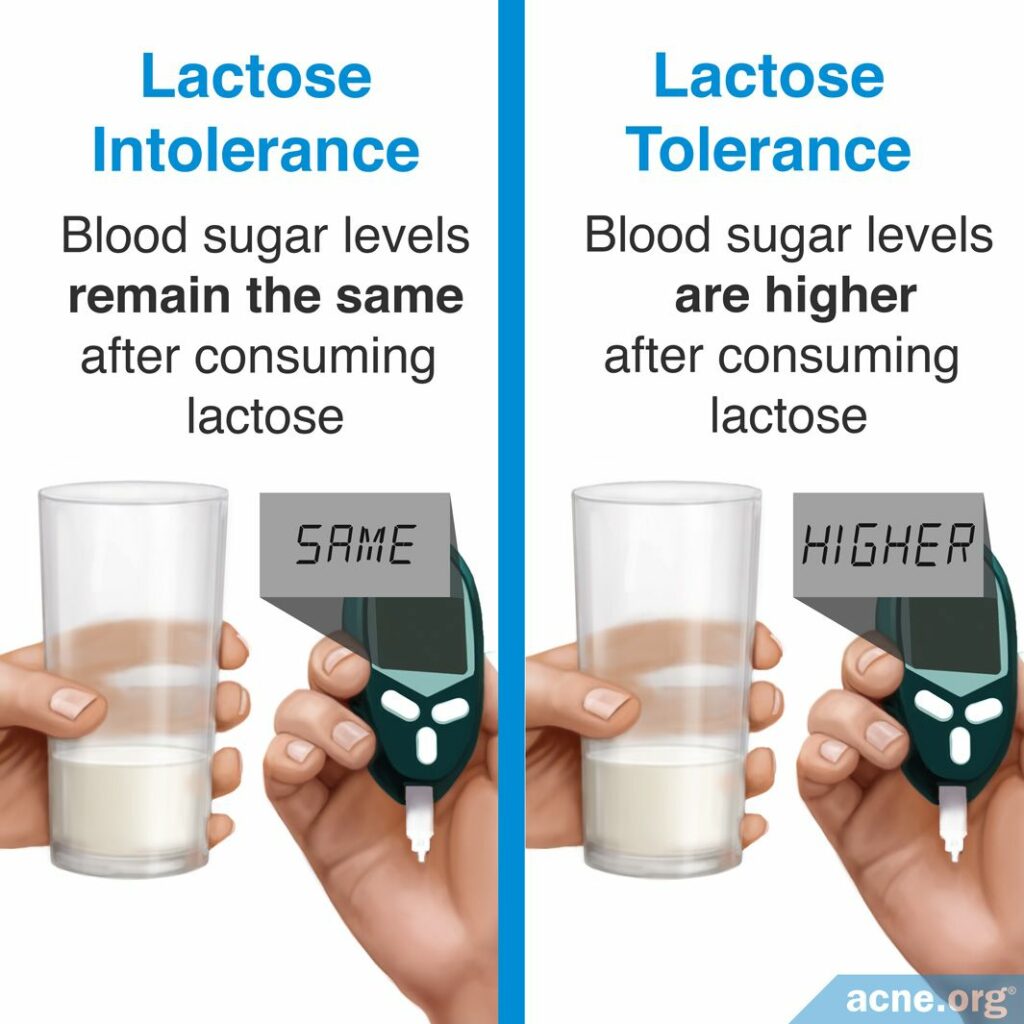
When a lactose tolerant person ingests dairy, the lactase enzyme in their gut breaks down the lactose into two sugars:
- Glucose
- Galactose
In a person who is lactose intolerant and/or lactase-non-persistent, their gut cannot break down the lactose and convert it into these sugars.
In other words, when lactase tolerant people consume dairy they experience a blood sugar spike.3
Some evidence shows that eating sugary foods may lead to blood sugar spikes, which then leads to a hormonal cascade that might lead to more acne symptoms. Could it simply be that people who are lactose tolerant end up with more sugar in their bloodstream after consuming dairy? It’s an interesting hypothesis, but far from proven. We will need much more research in this area before we can say for sure.
Lactose Tolerant or Intolerant: What Does This Entail for Me?
Not everybody with lactase non-persistence experiences lactose intolerance. If you are lactase-non-persistent and only consume a small amount of lactose-containing foods throughout the day, you may not experience any symptoms. As you can see from the table below, some dairy products have more or less lactose than others.4
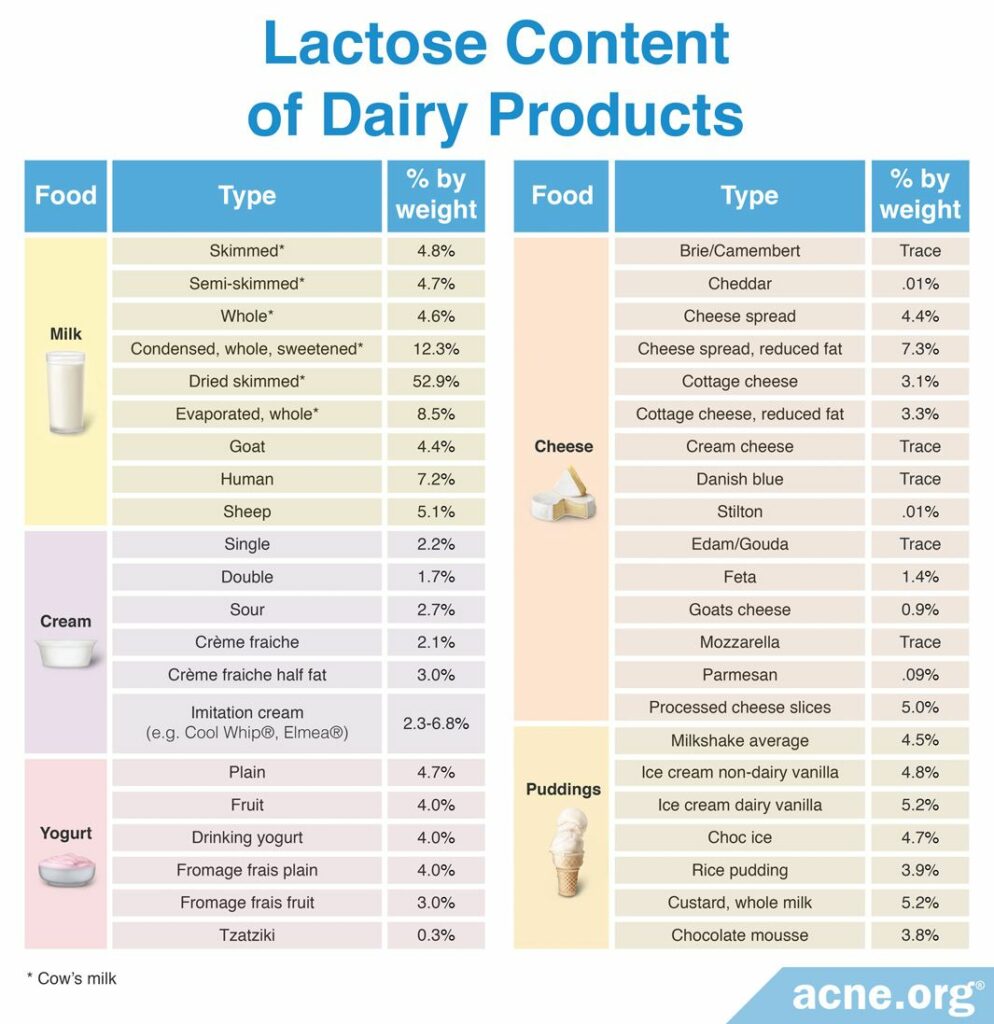
People who are lactose intolerant and wish to reduce or eliminate symptoms may choose to completely avoid foods containing lactose.4
There currently is no treatment for lactose intolerance, but there are over-the-counter tablets that contain the lactase enzyme. These tablets should be taken at the beginning of a meal so that the lactase enzyme in the tablets can provide enough lactase in the bowel. Studies show that these tablets are effective in reducing the symptoms of lactose intolerance.3
If you experience no problems when consuming dairy products, yet suffer from acne, you may want to try reducing the consumption of such products to see whether that results in fewer breakouts. We know that digesting lactose causes a rise in blood sugar, and this may affect acne. Even if it does to some degree, eliminating dairy is unlikely to clear the skin, but it could be something interesting to try. For more information, see this article on diet and acne.
